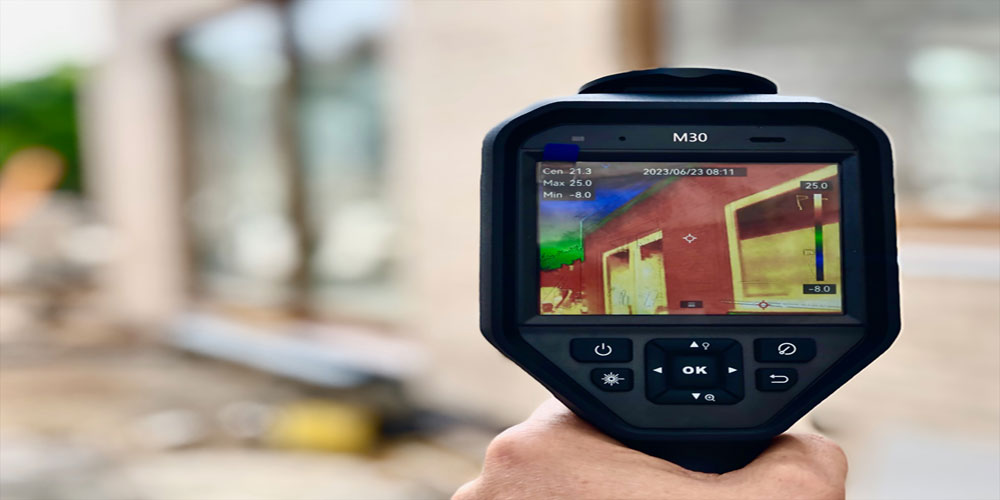
Thermal Imaging on Building Envelopes
Optimal Environmental Conditions for Conducting Thermal Imaging on Building Envelopes
Thermal imaging (infrared surveys) has become an essential tool for assessing the condition of building envelopes. However, to consistently achieve accurate and reliable results, it’s crucial to conduct thermal imaging under the correct environmental conditions. In this article, we’ll explore the best conditions for APTs thermal imaging surveys, and how they contribute to effective building envelope assessments for BREEAM and/or building control signoff.

Understanding Thermal Imaging for Building Envelopes
When we undertake a Thermal imaging, or infrared thermography on your building, it involves capturing and analysing the infrared radiation emitted by the materials within the building envelope. When applied to building envelopes, thermal imaging can reveal temperature variations and anomalies that may indicate issues such as insulation deficiencies, air leaks, and moisture intrusion. To ensure these observations are precise, certain environmental factors must be considered and accounted for, they are:
Temperature Differences between internal and external
A significant temperature difference between the interior and exterior of the building is key to effective thermal imaging. This temperature gradient helps highlight thermal anomalies more clearly. For most accurate results, a temperature difference of at least 10°C (18°F) is recommended. Conducting thermal imaging during the early morning or late evening, when outdoor temperatures are cooler and there is less solar loading, can create the necessary contrast.
Weather Conditions on the day of the survey
Clear weather conditions are ideal for thermal imaging on the day of the survey. Avoid conducting thermal inspections during rain, snow, or heavy wind, as these conditions can affect the accuracy of the readings. Moisture from rain or snow can mask thermal patterns, while strong winds can cause rapid temperature changes that lead to inaccurate results.

Solar Radiation
For better accuracy, solar loading must be minimised whenever possible. Direct sunlight can heat building surfaces unevenly, creating false thermal patterns. It’s best to perform thermal imaging either early in the morning or late in the evening, when the sun’s impact is minimal. Alternatively, cloudy days can also provide suitable conditions, as cloud cover diffuses solar radiation and reduces its impact on the building envelope and provides better thermal images.
Surface Moisture on building envelopes
Wherever possible, ensure that the building surfaces (roof, walls and floor) are dry before conducting thermal imaging. Moisture on the surface of the building can absorb and emit infrared radiation differently, leading to misleading results. After rainfall, it’s advisable to wait until the surfaces have dried completely before performing thermal inspections.
Humidity Levels
Moderate humidity levels are preferable for thermal imaging. Extremely high humidity can cause condensation on building surfaces, affecting thermal readings. Conversely, very low humidity can lead to rapid temperature changes that may impact the accuracy of the results. Aim for humidity levels between 30% and 60% for optimal conditions for the best results.
Wind Speed
Low wind conditions are ideal for thermal imaging. Strong winds can cause rapid cooling or heating of building surfaces, making it difficult to obtain accurate temperature readings. Conduct thermal inspections during periods of calm or light winds to ensure stable and consistent thermal patterns and better accuracy.
Conclusion
Conducting thermal imaging on building envelopes under the right environmental conditions is essential for obtaining accurate and reliable results. By considering factors such as temperature differences, weather conditions, solar radiation, surface moisture, humidity levels, and wind speed, property owners and inspectors can effectively identify and address issues within building envelopes. By optimizing these conditions, thermal imaging can provide valuable insights into the health and efficiency of buildings.
Why use us for your Thermal Imaging Surveys
We have many years’ experience in all aspects of thermal imaging to all types of commercial buildings. All our thermographic surveys are conducted by engineers qualified in accordance with BS EN 13187 and are trained to 3.
We only use the highest quality thermal imaging cameras, our thermal imaging equipment is some the best and most accurate on the market, ensuring we pick up faults that other equipment may miss.
Here is a quick breakdown of our service:
Thermal Imaging Service
- Supply of an ITC trained Level 3 thermographer
- We use large format/high sensitivity FLIR P6n-Series (640×480 resolution) thermal imaging cameras.
- Comprehensive report to include Introduction and fault cover pages, summary problem pages, elevation inventory,
- Detailed fault documentation pages with possible root cause and remedial recommendation (isotherm included if using equations), baseline IR and DC image of every elevation (100% coverage-no isotherm)
- Application of thermal indexing formulas
- Eco Friendly Email Report
Please contact us for more information
If you would like to contact us for more information on our thermal imaging services, please contact us on 01525 303905 or email us at info@aptsoundtesting.co.uk